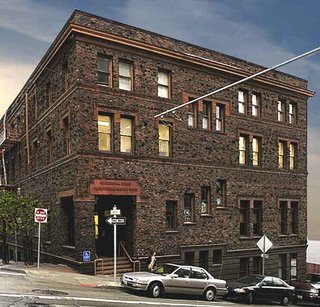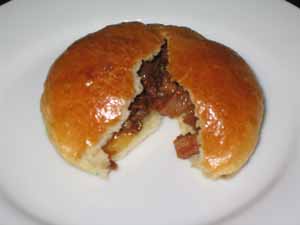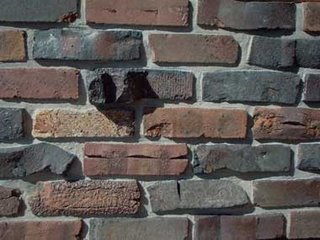
Last Friday I went with my friends Anna and Suzanne to visit Donaldina Cameron House, “a Chinatown-based multi-service agency serving Asian communities in the San Francisco Bay Area…serving individuals, immigrant families and youth since 1874.”
The day started with Suzanne guiding us off the freeway and across the sometimes confusing Market Street and Financial District areas. Suzanne’s family came to San Francisco from China several generations ago, and she still has strong connections to the Chinatown community.
Also, since she spent much of her childhood riding Muni around the City, she has a much better sense of urban direction than I, and makes brutal fun of Annie Kincaid’s travails making her way up and down one-way streets (Annie, quite coincidentally, shares my knack for getting lost).
 We were a little early for our scheduled tour of Cameron House, so we stopped off in a tiny Stockton Street bakery for a snack of tea and char siu bau, or steamed buns stuffed with barbecued pork. I’m not a pancake-and-eggs kind of gal, so this was just my kind of breakfast.
We were a little early for our scheduled tour of Cameron House, so we stopped off in a tiny Stockton Street bakery for a snack of tea and char siu bau, or steamed buns stuffed with barbecued pork. I’m not a pancake-and-eggs kind of gal, so this was just my kind of breakfast.I am interested in Cameron House because in Book 4 of the Art Lover’s Mystery Series – (yet to be named…any title ideas? Send them on over!)--I wanted to explore some of the tunnels that are rumored to criss-cross parts of Chinatown and Nob Hill. Suzanne told me she had heard whispers about such things, but assumed the stories were myths. Anna said she had seen tunnels under parts of L.A. A little research on the web turned up discussions (and sometimes pictorial evidence) of similar tunnels in Vancouver B.C., Portland, and…Red Bluff, of all places (a small city in California’s Central Valley.)
 What were the tunnels used for? As Suzanne’s cousin Jon told us over a delicious meal of dim sum later that day, “they were used for anything you didn’t want people to know about.” Hmm. To a mystery writer, those words are just begging for a little more explanation… perhaps with a judicious application of artistic license, just to make things really exciting.
What were the tunnels used for? As Suzanne’s cousin Jon told us over a delicious meal of dim sum later that day, “they were used for anything you didn’t want people to know about.” Hmm. To a mystery writer, those words are just begging for a little more explanation… perhaps with a judicious application of artistic license, just to make things really exciting. Suzanne’s cousin Shellee works at Cameron House, so she gave us a little history of the place and a tour. The building is a beautiful brick structure on the corner of Sacramento Street and . One of the first things we noticed as we walked toward building were the unusual, twisted bricks that speckle the walls in a pattern. Shellee told us these are called “clinker” bricks because they were partially melted from the heat of the flames and explosions during the 1906 earthquake. Apparently Cameron House survived the initial earthquake (amazing for a brick structure) and rampant fire that spread through the city, but was then dynamited to provide a fire break in an attempt to save the nearby Nob Hill mansions (this turned out to be a futile effort – all but the Flood Mansion were destroyed.)
Suzanne’s cousin Shellee works at Cameron House, so she gave us a little history of the place and a tour. The building is a beautiful brick structure on the corner of Sacramento Street and . One of the first things we noticed as we walked toward building were the unusual, twisted bricks that speckle the walls in a pattern. Shellee told us these are called “clinker” bricks because they were partially melted from the heat of the flames and explosions during the 1906 earthquake. Apparently Cameron House survived the initial earthquake (amazing for a brick structure) and rampant fire that spread through the city, but was then dynamited to provide a fire break in an attempt to save the nearby Nob Hill mansions (this turned out to be a futile effort – all but the Flood Mansion were destroyed.)According to legend, Donaldina Cameron braved the National Guard with “shoot to kill” orders in order to rush back into the building for the papers that gave her guardianship to dozens of girls. Without these documents, the Presbyterian missionary feared the girls would be taken out of her control and given back to their “employers.” Donaldina Cameron spent much of her life rescuing immigrant girls, mostly from China, who had been brought to the United States under false pretenses and forced into lives of prostitution or near-slavery as house servants.
 As Shellee showed us around, she told us about the wonderful summer programs and youth programs and after-school programs offered at Cameron House, and showed us the elevated basketball court with a great view of San Francisco recently used in the movie, the Pursuit of Happyness. Finally, we descended the basement stairs, wound through several elders packing grocery bags in the pantry, and Shellee opened the doors to cabinets full of sports equipment. As she said, it didn’t really look like much. The ends were capped with wallboard, but according to Shellee, these were once entrances to the tunnels where Cameron had allegedly hidden her rescued girls from their captors.
As Shellee showed us around, she told us about the wonderful summer programs and youth programs and after-school programs offered at Cameron House, and showed us the elevated basketball court with a great view of San Francisco recently used in the movie, the Pursuit of Happyness. Finally, we descended the basement stairs, wound through several elders packing grocery bags in the pantry, and Shellee opened the doors to cabinets full of sports equipment. As she said, it didn’t really look like much. The ends were capped with wallboard, but according to Shellee, these were once entrances to the tunnels where Cameron had allegedly hidden her rescued girls from their captors.Hmm. Were they really tunnels? Are there other tunnels? Are any of them still connected? What are they used for? Perhaps Book 4 will tell all….
No comments:
Post a Comment